Abstract
The differential code bias (DCB) in satellites of the Global Navigation Satellite Systems (GNSS) should be precisely corrected when designing certain applications, such as ionospheric remote sensing, precise point positioning, and time transfer. In the case of COMPASS system, the data used for estimating DCB are currently only available from a very limited number of global monitoring stations. However, the current GPS/GLONASS satellite DCB estimation methods generally require a large amount of geographically well-distributed data for modeling the global ionospheric vertical total electron content (TEC) and are not particularly suitable for current COMPASS use. Moreover, some satellites with unstable DCB (i.e., relatively large scatter) may affect other satellite DCB estimates through the zero-mean reference that is currently imposed on all satellites. In order to overcome the inadequacy of data sources and to reduce the impact of unstable DCB, a new approach, designated IGGDCB, is developed for COMPASS satellite DCB determination. IGG stands for the Institute of Geodesy and Geophysics, which is located in Wuhan, China. In IGGDCB, the ionospheric vertical TEC of each individual station is independently modeled by a generalized triangular series function, and the satellite DCB reference is selected using an iterative DCB elimination process. By comparing GPS satellite DCB estimates calculated by the IGGDCB approach based on only a handful (e.g., seven) of tracking stations against that calculated by the currently existing methods based on hundreds of tracking stations, we are able to demonstrate that the accuracies of the IGGDCB-based DCB estimates perform at the level of about 0.13 and 0.10 ns during periods of high (2001) and low (2009) solar activity, respectively. The iterative method for DCB reference selection is verified by statistical tests that take into account the day-to-day scatter and the duration that the satellites have spent in orbit. The results show that the impact of satellites with unstable DCB can be considerably reduced using the IGGDCB method. It is also confirmed that IGGDCB is not only specifically valid for COMPASS but also for all other GNSS.
Similar content being viewed by others
References
Camargo PO, Monico JFG, Ferreira LDD (2000) Application of ionospheric corrections in the equatorial region for L1 GPS users. Earth Planets Space 52(11): 1083–1089
Ciraolo L, Azpilicueta F, Brunini C, Meza A, Radicella SM (2007) Calibration errors on experimental slant total electron content (TEC) determined with GPS. J Geod 81(2): 111–120. doi:10.1007/s00190-006-0093-1
Coco DS, Coker C, Dahlke SR, Clynch JR (1991) Variability of GPS satellite differential group delay biases. IEEE T Aero Elec Sys 27(6): 931–938. doi:10.1109/7.104264
Conte J, Azpilicueta F, Brunini C (2011) Accuracy assessment of the GPS-TEC calibration constants by means of a simulation technique. J Geod 85(10): 1–8. doi:10.1007/s00190-011-0477-8
Feltens J (1998) IGS ionosphere models comparison. In: Paper presented at IGS presentation. JPL Ionosphere Workshop, Pasadena
Feltens J (2003) The activities of the Ionosphere Working Group of the International GPS Service (IGS). GPS Solut 7(1): 41–46. doi:10.1007/s10291-003-0051-9
Feltens J, Dow JM (2006) Realized and planned improvements in ESA/ESOC ionosphere modeling. In: Paper presented at IGS Workshop, Darmstadt
Feltens J (2007) Development of a new three-dimensional mathematical ionosphere model at European Space Agency/European Space Operations Centre. Space Weather 5(12): S12002. doi:10.1029/2006SW000294
Georgiadiou Y (1994) Modeling the ionosphere for an active control network of GPS stations. LGR-Series-Publications of the Delft Geodetic Computing Centre 7(1)
Hernández-Pajares M, Juan JM, Sanz J, Sol JG (1998) Global observation of the ionospheric electronic response to solar events using ground and LEO GPS data. J Geophys Res 103(A9): 20789–20796. doi:10.1029/98JA01272
Hernández-Pajares M, Juan JM, Sanz J (1999) New approaches in global ionospheric determination using ground GPS data. J Atmos Sol Terr Phys 61(16): 1237–1247. doi:10.1016/S1364-6826(99)00054-1
Hernández-Pajares M, Juan J, Sanz J, Orus R, Garcia-Rigo A, Feltens J, Komjathy A, Schaer S, Krankowski A (2009) The IGS VTEC maps: a reliable source of ionospheric information since 1998. J Geod 83(3): 263–275. doi:10.1007/s00190-008-0266-1
IS-GPS (2004) Navstar GPS space segment/navigation user interfaces (ICD-GPS-200D), Revision D, ARINC Engineering Services, LLC, El Segundo, CA, USA
Komjathy A, Sparks L, Wilson BD, Mannucci AJ (2005) Automated daily processing of more than 1000 ground-based GPS receivers for studying intense ionospheric storms. Radio Sci 40(6): S6006. doi:10.1029/2005RS003279
Kouba J (2009) A guide to using International GNSS Service (IGS) products. http://www.igs.org/igscb/resource/pubs/UsingIGSProductsVer21.pdf
C.I.O.T.Jet Propulsion Lab.: (1988) A comparison of mapped and measured total ionospheric electron content using global positioning system and beacon satellite observations. Radio Sci 23(4): 483–492. doi:10.1029/RS023i004p00483
Leandro RF, Langley RB, Santos MC (2007) Estimation of P2-C2 biases by means of Precise Point Positioning. In: Paper presented at proceedings of the 63rd annual meeting of the Institute of Navigation, Cambridge, MA, April 23–25, pp 225–231
Mannucci AJ, Wilson BD, Yuan DN, Ho CH, Lindqwister UJ, Runge TF (1998) A global mapping technique for GPS-derived ionospheric total electron content measurements. Radio Sci 33(3): 565–582. doi:10.1029/97RS02707
Mannucci AJ, Iijima BA, Lindqwister UJ, Pi X, Sparks L, Wilson BD (1999) GPS and ionosphere, review of Radio Science 1996–1999. Oxford University Press, New York
Mayer C, Becker C, Jakowski N, Meurer M (2011) Ionosphere monitoring and inter-frequency bias determination using Galileo: First results and future prospects. Adv Space Res 47(5): 859–866. doi:10.1016/j.asr.2010.12.006
Orús R, Hernández-Pajares M, Juan JM, Sanz J (2006) Current status and expected improvements of ionospheric reprocessing. In: Paper presented at IGS Workshop, Darmstadt
OS-SIS-ICD (2010) European GNSS (Galileo) open service signal in space interface control document, Issue 1.1, European Union
Otsuka Y, Ogawa T, Saito A, Tsugawa T, Fukao S, Miyazaki S (2002) A new technique for mapping of total electron content using GPS network in Japan. Earth Planets Space 54(1): 63–70
Øvstedal O (2002) Absolute positioning with single-frequency GPS receivers. GPS Solut 5(4): 33–44. doi:10.1007/PL00012910
Pérez RO (2005) Contributions on the improvement, assessment and application of the Global Ionospheric VTEC Maps computed with GPS data, PhD thesis, Universitat Politecnica de Catalunya, Barcelona, Spain
Rao GS (2007) GPS satellite and receiver instrumental biases estimation using least squares method for accurate ionosphere modeling. J Earth Syst Sci 116: 407–411. doi:10.1007/s12040-007-0039-x
Ray J, Senior K (2005) Geodetic techniques for time and frequency comparisons using GPS phase and code measurements. Metrologia 42(4): 215–232. doi:10.1088/0026-1394/42/4/005
Sardon E, Rius A, Zarraoa N (1994) Estimation of the transmitter and receiver differential biases and the ionospheric total electron content from Global Positioning System observations. Radio Sci 29(3): 577–586. doi:10.1029/94RS00449
Sardon E, Zarraoa N (1997) Estimation of total electron content using GPS data: how stable are the differential satellite and receiver instrumental biases?. Radio Sci 32(5): 1899–1910. doi:10.1029/97RS01457
Sarma AD, Rao GS, Rao PVDS, Ramalingam K (2008) GPS satellite and receiver instrumental biases estimation using SVD algorithm. IEEE T Aero Elec Sys 44(4): 1560–1566. doi:10.1109/TAES.2008.4667731
Schaer S (1999) Mapping and predicting the earth’s ionosphere using the global positioning system, PhD thesis, Astronomical Institutes, University of Bern, Berne, Switzerland
Wen D, Liu S, Tang P (2010) Tomographic reconstruction of ionospheric electron density based on constrained algebraic reconstruction technique. GPS Solut 14(4): 375–380. doi:10.1007/s10291-010-0161-0
Wilson BD, Mannucci AJ (1993) Instrumental biases in ionospheric measurement derived from GPS data. In: Paper presented at proceedings of the ION GPS-93, Salt Like City, UT, USA, September 22–24, pp 1343–1351
Wilson BD, Yinger CH, Feess WA, Shank C (1999) New and improved: the broadcast interfrequency biases. GPS World 10(9): 56–66
Yuan Y, Ou J (1999) The effects of instrumental bias in GPS observations on determining ionospheric delays and the methods of its calibration. Acta Geod Cartogr Sin 2(28): 110–114. doi:cnki:ISSN:1001-1595.0.1999-02-002
Yuan Y, Ou J (2004) A generalized trigonometric series function model for determining ionospheric delay. Prog Nat Sci 14(11): 1010–1014. doi:10.1080/10020070412331344711
Yuan Y, Huo X, Ou J (2007) Models and Methods for precise determination of ionospheric delays using GPS. Prog Nat Sci 17(2): 187–196. doi:10.1080/10020070612331343245
Zhou J (1985) Quasi-stable adjustment of monitoring networks. In: Zhou J, Tao B, Zhuang K (eds) Proceedings of quasi-stable adjustment (in Chinese). Surveying and Mapping Press, Beijing, pp 9–19
Author information
Authors and Affiliations
Corresponding authors
Rights and permissions
About this article
Cite this article
Li, Z., Yuan, Y., Li, H. et al. Two-step method for the determination of the differential code biases of COMPASS satellites. J Geod 86, 1059–1076 (2012). https://doi.org/10.1007/s00190-012-0565-4
Received:
Accepted:
Published:
Issue Date:
DOI: https://doi.org/10.1007/s00190-012-0565-4




